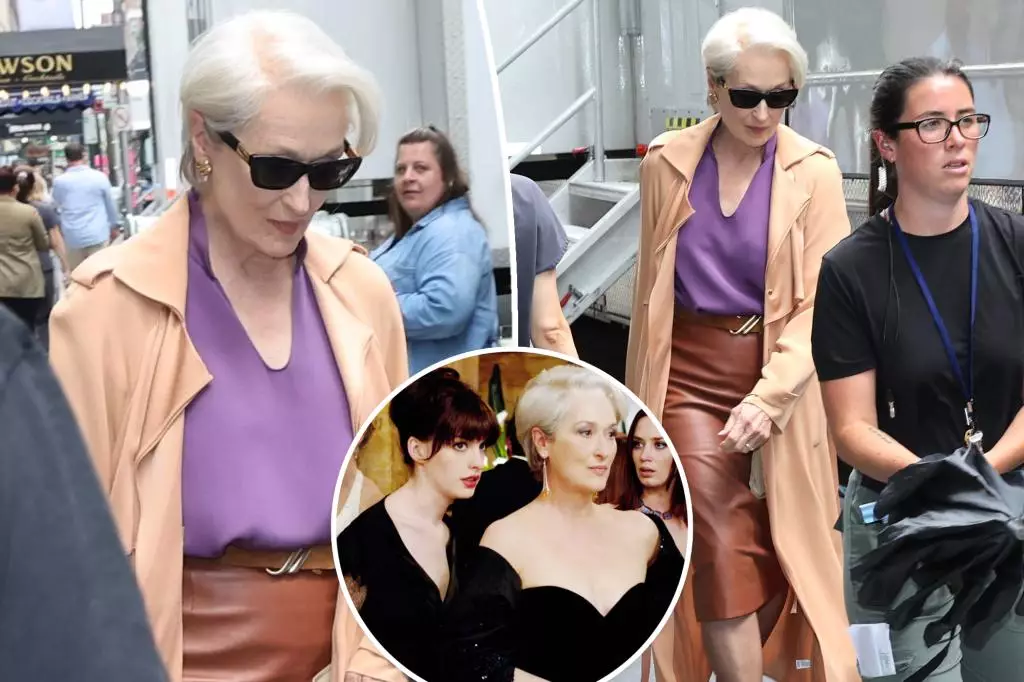The return of *The Devil Wears Prada* franchise marks not just a sequel but a cultural revival that delves deeper into the complex world of fashion, power, and ambition. With Meryl Streep reprising her role as Miranda Priestly, the film promises to reignite our fascination with a character that embodies authority, sophistication, and an unyielding sense of style. This new installment feels like more than a mere continuation; it’s a bold statement about resilience amidst change, especially as the magazine industry grapples with digital transformation.
Streep’s appearance on set, sporting her signature icy white pixie cut, signals the film’s commitment to authenticity and iconic imagery. Her commanding presence, cloaked in a chic tan trench coat and accessorized with subtle yet sophisticated touches, signals a return to the character’s formidable persona. The visual cues suggest the sequel will maintain the allure and intimidation factor that made Miranda Priestly a standout figure in cinematic history, but it also hints at new complexities as the industry evolves.
This sense of continuity combined with evolution is essential. It taps into our deeply rooted fascination with the clash between power and vulnerability, and it invites us to see how a character so entrenched in her world can adapt—or confront—new challenges. The film doesn’t merely aim to entertain; it offers a mirror to our ongoing societal shifts, where traditional notions of authority are being reshaped in real time.
New Faces and Fresh Dynamics Drive Anticipation
The casting choices and plot developments signal a significant shift in the narrative landscape. The inclusion of Kenneth Branagh as Miranda Priestly’s husband introduces a new personal dimension, adding layers of complexity to her character beyond her ruthless professional exterior. Meanwhile, Lucy Liu, Justin Theroux, and B.J. Novak’s involvement suggests a diverse and dynamic cast that will diversify the storytelling and perhaps explore new facets of the fashion industry.
The returning cast, notably Anne Hathaway’s Andy Sachs and Emily Blunt’s Emily, indicates a storyline that balances legacy characters with contemporary dilemmas. Hathaway’s social media teaser, dressed in a shade of blue reminiscent of the original film, functions as a subtle yet powerful homage that fuels nostalgic anticipation while signaling a fresh chapter. Her role seems poised to explore the modern realities of the fashion editor, perhaps confronting the loss of traditional print media and digital innovation head-on.
This duality of nostalgia and innovation is central to understanding why the sequel resonates. It’s not just about revisiting beloved characters; it’s about examining how they navigate a landscape that’s vastly different from the original’s setting. As the industry shifts, so too do the characters’ roles—mirroring real-world transformations—and this dynamic makes the sequel compelling and relevant.
The Cultural Significance of Fashion as Power
Meryl Streep’s own reflections on her experience embody the emotional depth behind the character she embodies. Her admission of difficulty in portraying Priestly underscores how deeply rooted her discomfort was in the persona’s intensity. It’s a reminder that power, especially when wielded so flawlessly in the media and fashion realms, often comes at a personal cost.
The character of Miranda Priestly symbolizes a certain form of power—the kind that commands respect, instills fear, and influences global trends. Her presence in the sequel seems designed to challenge not only her colleagues but also societal perceptions of authority and control. In a world increasingly questioning hierarchical structures, Priestly’s return signifies a reminder that real power involves a delicate balance of elegance, ruthlessness, and strategic cunning.
In a broader sense, the film’s resurrection invites us to reflect on the ongoing evolution of leadership styles. It is a cultural commentary — a reminder that even the most formidable figures must adapt or face obsolescence. As Priestly navigates her career amidst a declining print industry, the narrative becomes an allegory for resilience and reinvention, poignant in an era obsessed with innovation and transformation.
A Sequel as a Cultural Mirror
The buzz surrounding *The Devil Wears Prada 2* isn’t solely about fashion or star power—it’s about a deeper cultural conversation. The film acts as a prism reflecting our changing attitudes toward authority, femininity, and success. It challenges her audience to reconsider whether true influence resides in conforming to traditional standards or in redefining them.
Furthermore, the film’s release date—set for May 2026—furnishes ample time for audiences to anticipate how outdated notions of authority will collide with modern ideals. It’s an opportunity for viewers to witness how characters from a bygone era of print media confront the digital age—a metaphor for all industries facing disruption.
This sequel is more than a commercial enterprise; it is an opportunity to explore the resilience of iconic characters and how they embody broader societal changes. By revisiting these themes, the film offers a compelling lens into power structures and cultural shifts, making it not just a movie but an insightful commentary on our collective journey toward redefining influence.

